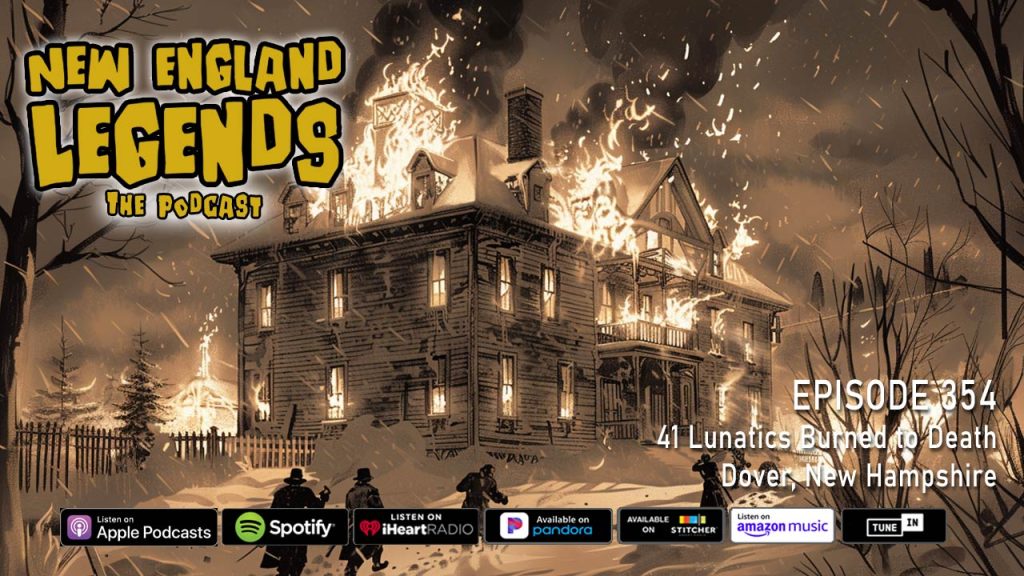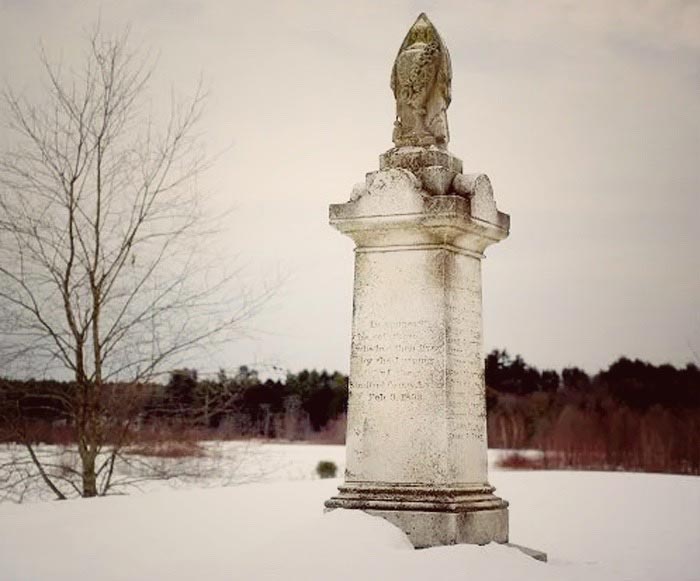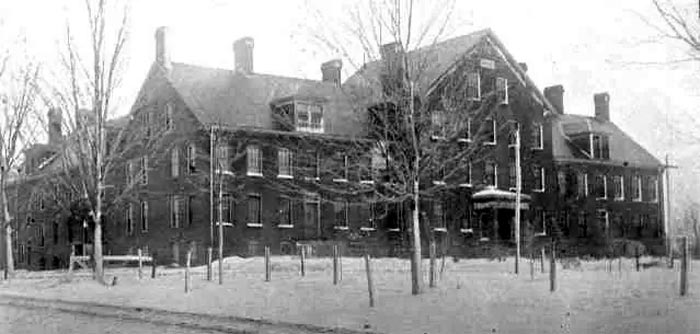
In Episode 354 Jeff Belanger and Ray Auger visit Dover, New Hampshire, to see the memorial to the Strafford County Lunatic Asylum fire. On February 9, 1893, a fire ravaged the old asylum building killing 41 people inside. The tragedy was an epic failure of a system meant to protect the most vulnerable.
BECOME A LEGENDARY PATRON:
https://www.patreon.com/NewEnglandLegends
CREDITS:
Produced and hosted by: Jeff Belanger and Ray Auger
Edited by: Ray Auger
Guest Voice Talent: Marv Anderson
Theme Music by: John Judd
SUBSCRIBE TO THE PODCAST FOR FREE:
Apple Podcasts/iTunes | Spotify | Pandora | Amazon Podcasts | TuneIn | iHeartRadio
JOIN OUR SUPER-SECRET:
New England Legends Facebook Group


EPISODE TRANSCRIPT:
*A note on the text: Please forgive punctuation, spelling, and grammar mistakes. Like us, the transcripts ain’t perfect.
[WALKING ON PAVEMENT]
RAY: This is a lovely little spot here in Dover, New Hampshire.
JEFF: It is, we’re walking behind a massive complex of buildings that includes an old folks home and the Strafford County Department of Correction. There are paths to walk down to the banks of the Cocheco River, and plenty of trees. But our destination is up this small hill on our left.
RAY: Okay, I can see what looks like a kind of headstone monument with an urn on the top.
JEFF: That’s the spot. It was near here that a horrible tragedy claimed a lot of lives. I know we often need to put tragic events behind us in order to move on, but at least we sometimes leave some kind of memorial behind to the fallen. It’s something to say they lived here and died here, and hopefully they didn’t die in vain.
RAY: I know what you mean. We can’t mourn anything forever. But we should also never forget. It’s tough to know where the balance is.
JEFF: Yes it is. Quite often the most vulnerable of our people are the first stories to be lost to history. We’re here to check out one such story. We’re in Dover, New Hampshire, to visit the site of Dover Insane Asylum Fire.
[INTRO]
JEFF: I’m Jeff Belanger.
RAY: And I’m Ray Auger. Welcome to episode 354 of the New England Legends podcast. Thanks for joining us on our mission to chronicle every legend in New England one story at a time. It’s a mission we can’t accomplish without you, so please contact us through our Web site anytime with your story leads. We love hearing from you.
JEFF: Also, Ray and I are thrilled to announce we’re holding our first New England Legends Podcast LIVE event Saturday, September 21st at 7PM in Milford, Massachusetts. It will be a night of stories, live music, and general weirdness. Our discounted Patreon Patron presale has ended. So now tickets are on sale for everyone. They’re $20 and are limited. You can buy them on our Web site.
RAY: We’ll explore this Dover tragedy right after this word from our sponsor.
SPONSOR
JEFF: There was a time when most counties were required to manage a poor farm. It was a place that was meant to be as self-sufficient as possible, where the inmates—as they were called—could grow their own food, make their own clothes, and not be a burden on the community. It was a place for those who couldn’t take care of themselves either from physical or mental disabilities, or widows and people of advanced years who couldn’t be on their own anymore.
RAY: That sounds reasonable.
JEFF: It was! And the system worked to varying degrees. Some poor farms were better run than others, of course. Some did require communities to pony up extra taxes to pay for the care of these folks. And some people in those communities didn’t like that one bit. Later on, many poor farms turned into asylums that mostly focused on people with mental disabilities. That system also had a pretty good run until the 1980s when deinstitutionalization shut down many of the state-run mental health facilities which led to a dramatic rise in our homeless and prison populations, because some folks simply can’t make it on their own. They need to be in some kind of institution.
RAY: That is so tragic. So here’s a little more information on Dover, New Hampshire. Dover is technically a seacoast town with its southeastern edge sitting near where the Piscataqua River meets the Atlantic Ocean. This region that was once Abenaki land, was first settled by Europeans in 1623. The town built up on the back of the fishing industry. As farms and more businesses moved in, the population grew, and they needed a poor farm.
JEFF: Right. A place for people who can’t take care of themselves.
RAY: Dover’s poor farm was built on land purchased from a man named Timothy Snell, and sat next to John Trickey’s farm by the Cocheco River. Next to the poor farm, an asylum building was built. The Institution featured 56 cells in a two-and-a-half story wooden building with windows covered with metal bars and screening to keep people inside from escaping. In 1866 the county took control of the poor farm and focused more on care for quote “incurable insane paupers.” This facility wasn’t without its controversy. In the latter half of the 1800s, boarding each pauper cost the town about $1.50 per week. That would be about $36 dollars in today’s money.
JEFF: Not too much.
RAY: No. But multiply that by 50 people and you’re looking at about $1800 a week in today’s money.
JEFF: Which is still pennies considering you’re housing and feeding 50 people.
RAY: Multiple that by 52 weeks, and you have some locals who don’t believe they should have to foot the bill for these people. The pressure was on, so at times the town selectmen tried to push some of the homeless into other jurisdictions and counties so they became someone else’s problem.
JEFF: So that was the struggle with the poor farm and asylum in the late 1800s. Let’s head back to 1893 and visit Dover.
[TRANSITION]
[WINTER WIND SLOW FADE]
RAY: It’s early February of 1893. It’s been bitterly cold out lately here in Dover, New Hampshire. The cold conditions are amplified inside the Strafford County Lunatic Asylum. The Asylum is its own building, while the Workhouse sits about 60 feet away in another building.
JEFF: The way the asylum was constructed there are gaps between the floorboards to the point where you can see through to different levels.
RAY: The building is drafty, not well-insulated, and the people inside sometimes shiver from the cold.
JEFF: But that’s life inside the asylum. It’s not meant to be a life of luxury, but it is meant to help people survive when they have nowhere else to go, and to help these folks live a fuller life—which is helpful considering it wasn’t that long ago that people with mental disorders or disabilities were either locked in prisons or even chained up in the attics or basements by their families who are too embarrassed to have these family members be seen by the public.
[WINTER WIND BUILDING]
RAY: It’s Thursday evening. February 9th. The winter storm outside has been building for hours. It’s cold. The wind is whipping, and the snow is falling in almost white-out conditions.
JEFF: It’s about 10PM when night watchman Wilburn Chisley gets up to make his rounds.
[SOMTEHTING FALLING IN DISTANCE]
JEFF: Chisley hears something coming from one of the cells. As he draws closer, he smells something unmistakable.
RAY: Smoke!
JEFF: Definitely. It’s coming from that room over there where they’re holding Mary La Fontaine.
[FIRE STARTS]
JEFF: When Chisley draws closer, he can see flames leaping inside the cell.
[WOMAN SCREAMS]
JEFF: And now there’s a panic. The woman inside has barricaded herself in the room.
[KEYS JINGLE / DOOR UNLOCKS]
RAY: The night watchman struggles with the door and tries to pulls the inmate out of her burning cell. With the door open, it’s clear this fire is spreading quickly to the other cells.
[PEOPLE SCREAMING]
RAY: The other inmates are trapped in their cells as smoke and fire start to poor in.
JEFF: The night watchman panics. He sounds the alarm. Mr. William Driscoll, the keeper, and the attendants rush to the second floor where most of the inmates sleep. As they desperately try to unlock all of the doors and rouse the inmates, it’s soon clear they’re doomed. Flames are spreading everywhere. They’re trapped.
[BELLS RINGING]
RAY: Someone from the workhouse next door saw the flames outside and was already racing into downtown Dover to summon the fire brigade.
[HORSES GALLOPING]
RAY: The fire wagon is quickly hitched and soon en route to the fire at the asylum. But the going is painfully slow considering the winter storm and blinding, slippery conditions.
JEFF: Meanwhile back at the asylum, the scene is true horror.
[FIRE]
[SCREAMS IN THE DISTANCE]
JEFF: Screams can be heard coming from the building, as well as maniacal laughter. Some inmates are even singing, unaware of the peril they’re in. One pauper from the workhouse next door describes the scene.
WITNESS: The flames are spreading with such rapidity that the building is one seething, hissing mass of fire. Tongues of flames leap about the skulls and bones of the cremated insane. The blaze seems to fill many of the demented people with ghoulish ideas. I saw women standing before the windows making the most hideous faces, even while the flames tipped their cheeks. The cries of the doomed prisoners were heart rendering. Hideous laughter mingled with prayers and appeals for help.
[WINTER WIND]
[RINGING BELL APPROACHING FROM DISTANCE]
RAY: It’s close to midnight when the fire brigade arrives. But it’s clear they’re far too late. The building is engulfed in flames.
[WIND FADES]
RAY: When morning comes, officials can see there are bones and charred bodies everywhere. Figuring out which bones belonged to which inmate is going to be impossible. They can only guess based on where the bones were found.
JEFF: Three people from the asylum managed to escape through one of the windows that weren’t barred. In the end, 41 people perished in the worst fire in state history. And that brings us back to today.
[TRANSITION]
JEFF: We should point out that there’s some discrepancy on the number. Some say it was 41 people who perished, others say 40. Either way, it’s one of the biggest fire tragedies in New Hampshire history. The building was leveled, and eventually a new facilities made of brick were built on these grounds. Those are the buildings we see around us today. And though the original asylum that burned to the ground was situated where a section of those new buildings now reside, this memorial was placed over here in sight of it.
Ray: After a full investigation, authorities determined many problems that led to this tragedy. First, the inmates who smoked were allowed to have matches. Mary LaFontaine smoked on occasion, so she had the matches. Second, the night watchman Mr. Chesley, by his own admission claimed he was unfit for the job. He had poor eyesight, and didn’t know—or wasn’t told—there was a water hose and a fire buck nearby. Neither were used to fight the blaze when it was still contained to the one room. They also found the construction of the building was poor, and the wood went up like a tinderbox. In short, the state and county failed these people, and they died.
JEFF: Today the monument reads: In memory of those who lost their lives in the burning of the Strafford County Asylum, February 9, 1893.
RAY: Thankfully, this tragedy hasn’t been repeated in New Hampshire, which gives us hope that maybe a painful lesson was learned.
[OUTTRO]
JEFF: And that takes us to After the Legend where we dive deeper into this week’s story and sometimes veer off course.
RAY: After the Legend is brought to you by our Patreon patrons! Our patreon patrons support everything we do. Without them, this podcast wouldn’t be possible. They help us with our production and hosting costs, with our marketing, and everything else it takes to bring you two stories each week. It’s just $3 bucks per month, and for that they get early ad-free access to new episodes plus bonus episodes and content that no one else gets to hear. AND they get discounts to our events. If you can help the cause, please head over to patreon.com/newenglandlegends.
To see some historic photos of the Dover Poor Farm and Asylum, click on the link in our episode description or go to our Web site and click on episode 353.
Some sources include: The Hull Evening News from Feb. 11, 1893, The New York Times, and the Dover Library.
Please hit that subscribe button wherever you get your podcasts, and be sure to like and share. We’d also be most grateful if you posted a review for us. Those reviews really help others find us. Please also get more involved! Join our New England Legends Facebook Group, download our free New England Legends app in your app store, and email us with your story ideas. Most of our story leads come from you!
We’d like to thank Marv Anderson for lending his voice acting talents this week. Thank you to our patrons. Thank you to our sponsors, and our theme music is by John Judd.
Until next time remember… the bizarre is closer than you think.
